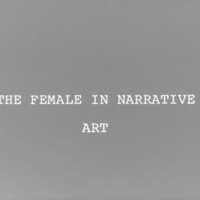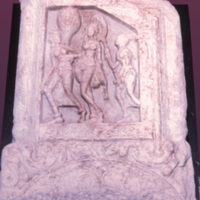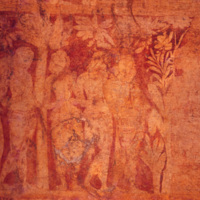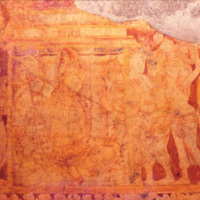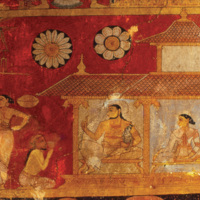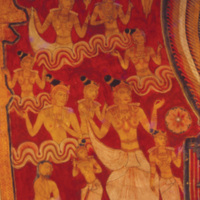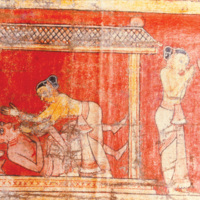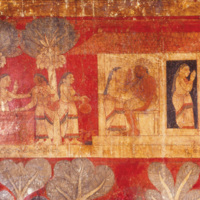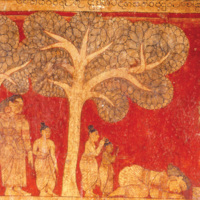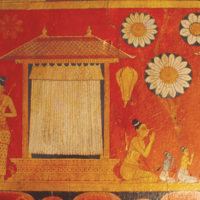Main Menu
AORC Libraries
Browse Items in The female in narrative art (15 total)
The female in narrative art
Description: The female in narrative art: A useful source for the study of conceptual positions regarding women in early Sri Lankan society is narrative art, which is largely in the form of painting. Unfortunately the chronological distribution of this material is extremely uneven, being weighted on the last two centuries of the period dealt with in this survey. Very little of the narrative paintings of the earlier period has survived.
Contributor: Co-Author: Seneviratna, Harsha
Collection: Women in Sri Lankan Sculpture and Painting
Tags: AISLS, ICES, PDWESLSP, The female in narrative art
Three women of different social grades
Description: In India, narrative sculpture is as old as Buddhist art itself, the impact of which was no doubt felt in Sri Lanka. This marble relief which belongs to the Amaravati art tradition of the early centuries of the Christian era appears to have been imported from India. The plaque was found in 1986 during excavations associated with the Cultural Triangle Project, near the so-called Buddhist Railing site close to the Jetavanarama stupa. The scene, which probably illustrates an episode in the life of Buddha, shows women of 3 different social grades, distinctly recognizable by their dress and functional positions. The plaque is among the exhibits of the National Museum in Colombo.
Contributor: Co-Author: Seneviratna, Harsha
Collection: Women in Sri Lankan Sculpture and Painting
Tags: AISLS, ICES, PDWESLSP, The female in narrative art
Paintings at the Tivanka Image House, life of the Buddha
Description: Many of the 12th and 13th century A.D. paintings at the Tivanka Image House in Polonnaruva are faded. However, some episodes from the life of the Buddha as well as Jataka stories can be identified. This scene shows a group of elite women associated with the events preceding the birth of prince Siddhartha.
Contributor: Co-Author: Seneviratna, Harsha
Collection: Women in Sri Lankan Sculpture and Painting
Tags: AISLS, ICES, PDWESLSP, The female in narrative art
A scene from a Jataka Story
Description: This one-time queen turned beggar, carrying her crippled lover, an illustration of the Cullapaduma Jataka (one of the former birth stories of the Buddha) at the Tivanka Image House.
Contributor: Co-Author: Seneviratna, Harsha
Collection: Women in Sri Lankan Sculpture and Painting
Tags: AISLS, ICES, PDWESLSP, The female in narrative art
A scene from a Jataka Story
Description: This is a scene from the Vessantara Jataka (one of the former birth stories of the Buddha) painted on the walls of the Madawela vihara at Bokkavela in the Kandy district. While noting the social differences among women themselves, the maid clothed only waist downwords, performing service tasks, and the queen sitting away from it all, one is also made aware of the role differences between male and female, the King appearing as the primary decision maker with the queen playing a secondary role. The paintings at Madavala Vihare belong to the 18th century A.D.
Contributor: Co-Author: Seneviratna, Harsha
Collection: Women in Sri Lankan Sculpture and Painting
Tags: AISLS, ICES, PDWESLSP, The female in narrative art
Women dancers as temptresses
Description: The temptations with which the Bodhisattva grappled are personified as the daughters of Mara, the evil one. In common with practically all the Kandyan temple paintings, the female as temptress, at the Dambulla Rock Temple, Sri Lanka, as shown here, is in dance pose. However, none of the daughters of Mara shown in the paintings of the Kandyan period can be described as sensuous creatures. For the 18th century Kandyan painter, the female as seductress perhaps lacked conviction.
Contributor: Co-Author: Seneviratna, Harsha
Collection: Women in Sri Lankan Sculpture and Painting
Tags: AISLS, ICES, PDWESLSP, The female in narrative art
A woman asserting her self over her aged husband
Description: Here is an occasion in which the female asserts herself over her aged husband in the Vessantara Jataka (one of the former birth stories of the Buddha). It is painted with great animation in this 18th century A.D., scroll painting found at the Arattana Vihare, Hanguranketa, Sri Lanka.
Contributor: Co-Author: Seneviratna, Harsha
Collection: Women in Sri Lankan Sculpture and Painting
Tags: AISLS, ICES, PDWESLSP, The female in narrative art
A painting on a temple wall, of a woman asserting herself over her aged husband
Description: This scene at the Degaldoruva Vihare in the Kandy district, Sri Lanka, is somewhat restrained, but is presented together with a group of women round a well, whose taunts provoke the young woman Amittatapa (Vessantara Jataka, one of the former birth stories of the Buddha) to assert herself. Although these paintings are only a visual expression of earlier literary woks, the choice of episodes and the manner in which they are presented may reveal 18th century attitudes.
Contributor: Co-Author: Seneviratna, Harsha
Collection: Women in Sri Lankan Sculpture and Painting
Tags: AISLS, ICES, PDWESLSP, The female in narrative art
Queen Madri-devi worshipping her husband (Vessantarā)
Description: This painter at Degaldoruva, illustrating another episode in the Vessantara Jataka (one of the former birth stories of the Buddha), shows Madri-devi worshipping at the feet of her husband when she sees him in the garb of an ascetic.
Contributor: Co-Author: Seneviratna, Harsha
Collection: Women in Sri Lankan Sculpture and Painting
Tags: AISLS, ICES, PDWESLSP, The female in narrative art
Queen Madri-devi worshipping her husband (Vessantarā)
Description: This scene painted at the Madavala Vihare, shows the queen worshipping Vessantara (Vessantara Jataka, one of the former birth stories of the Buddha), holding her head straight.
Contributor: Co-Author: Seneviratna, Harsha
Collection: Women in Sri Lankan Sculpture and Painting
Tags: AISLS, ICES, PDWESLSP, The female in narrative art



